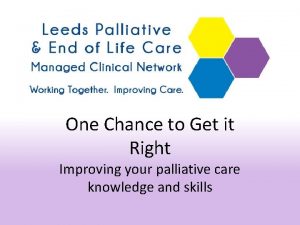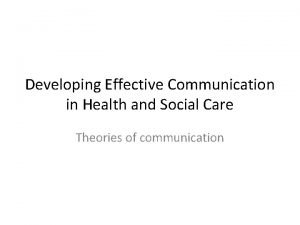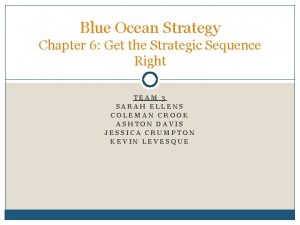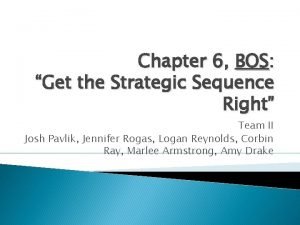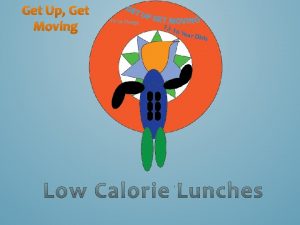One Chance to Get it Right Equipping Health




















- Slides: 20

One Chance to Get it Right Equipping Health Professionals for the Challenges of Caring for Patients Approaching the End of Life Dr Beth Thomas Marie Mc. Donnell Dr Teresa Beynon Michelle Morris Sally Halford Simulation and Interactive Learning (Sa. IL) Centres

Welcome Course Outline: · · · · · Housekeeping Introduction Course aims Introduction to human factors, non-technical skills and simulation Principles of the Sa. IL Centre Familiarisation Session - ‘Meet the Manikin’ 5 Scenarios & Debriefs DNAR / Ethics Session Summary / Feedback / Close © Sa. IL Centre February 2014

Housekeeping Centre guidance: · · · · Fire Exits Toilets Air-Con Drinking water available Tea & coffee breaks Lunch Provided Keeping in touch & social media © Sa. IL Centre February 2014

Introductions Ice breaker

Course Aims · To provide a framework for reviewing your working environment and its effect on the patient experience and their safety · To explore some of the core issues of Non-Technical Skills (NTS) · To increase knowledge base of some clinical scenarios · To explore priorities for care of the dying person and implement this into your future practices © Sa. IL Centre February 2014

Fully Immersive Simulation Suite

Human Patient Simulation Using computer-controlled whole body manikins which breathe, have audible lung and heart sounds, palpable pulses, can blink and even speak. © Sa. IL Centre February 2014

The Control Room

Simulated Scenarios & Debrief Scenarios: · 5 x clinical simulation · All scenarios filmed & watched · Participants & observers The debriefing process: · Mixed modality · Learning shared by all Sa. IL model – Diamond · Description · Analysis · Application © Sa. IL Centre April 2015 · Depending on our personal experiences, sometimes the scenarios may feel very real and close-to-home

Principles of the Sa. IL Centre · Confidentiality / Professionalism · Performance in the centre does not reflect performance in real life · Enjoy! © Sa. IL Centre February 2014

What’s my role in the scenario? · You are you – Be yourself – Own level of competence – Standard professional behaviour · Suspend disbelief · NOT a test or assessment – Safe space to push yourself (you are allowed to make mistakes!) · Friendly supportive environment © Sa. IL Centre February 2014

What’s my role in the debrief? • Everyone is part of the debrief • Learn from each other • Bring your experiences/knowledge/skills to the table • Friendly supportive environment: - Mutual respect - Confidentiality - Constructive feedback © Sa. IL Centre March 2015

What’s the faculty’s role? • To provide a safe learning environment within the simulation and debrief • To ensure the smooth running of the day • To guide the discussions • Expert faculty will assist with technical/clinical questions

Why Simulation? Understanding Human Factors “The study of the interrelationships between humans, the tools they use, and the environment in which they live and work. ”

Why Simulation? Human Factors in Healthcare “Enhancing clinical performance through an understanding of the effects of teamwork, tasks, equipment, workspace, culture and organisation on human behaviour and abilities and application of that knowledge in clinical settings”. K Catchpole (2010), cited in Department of Health Human Factors Reference Group Interim Report, 1 March 2012, National Quality Board, March 2012. http: //www. england. nhs. uk/ourwork/part-rel/nqb/ag-min / © Sa. IL Centre April 2015


Non-Technical Skills in Healthcare Care & Compassion Cognitive or mental skills: Social skills: Decision making Team-working Planning Leadership Situation awareness Communication Triage / prioritization Effective coping with disruptions /distractions Efficient management of multiple patients/ issues

Don’t Forget! · Be yourself – own competence level · Introduce yourself · General Principles · Hand hygiene / infection control · Standard professional conduct © Sa. IL Centre February 2014

Go say “Hello” to our Patient! © Sa. IL Centre February 2014

Email: simulation@gstt. nhs. uk Website: http: //sailcentres. kcl. ac. uk/ @humanikin SAILcentreat. GSTT Sa. IL @ St. Thomas House, 1 st Floor St. Thomas House, St. Thomas’ Hospital, Westminster Bridge Road, London SE 1 7 EH 020 7188 ext. 84802 Email: simulation@gstt. nhs. uk Website: http: //sailcentres. kcl. ac. uk/
 Clarimed
Clarimed One chance to get it right
One chance to get it right Get on get off get into get out of
Get on get off get into get out of Chapter 21 equipping the kitchen
Chapter 21 equipping the kitchen What is the theme of the poem
What is the theme of the poem Right product right place right time right price
Right product right place right time right price Right time right place right quantity right quality
Right time right place right quantity right quality You never get second chance make first impression
You never get second chance make first impression The right man on the right place at the right time
The right man on the right place at the right time You only have one chance to make a first impression
You only have one chance to make a first impression Get up get moving quiz
Get up get moving quiz Get up get moving quiz
Get up get moving quiz Get up get moving
Get up get moving Pseudocode sequence
Pseudocode sequence Get focused get results
Get focused get results Germer
Germer Group communication in health and social care
Group communication in health and social care Buyer utility map example
Buyer utility map example Strategic sequence
Strategic sequence Get your mind right meaning
Get your mind right meaning One god one empire one emperor
One god one empire one emperor

